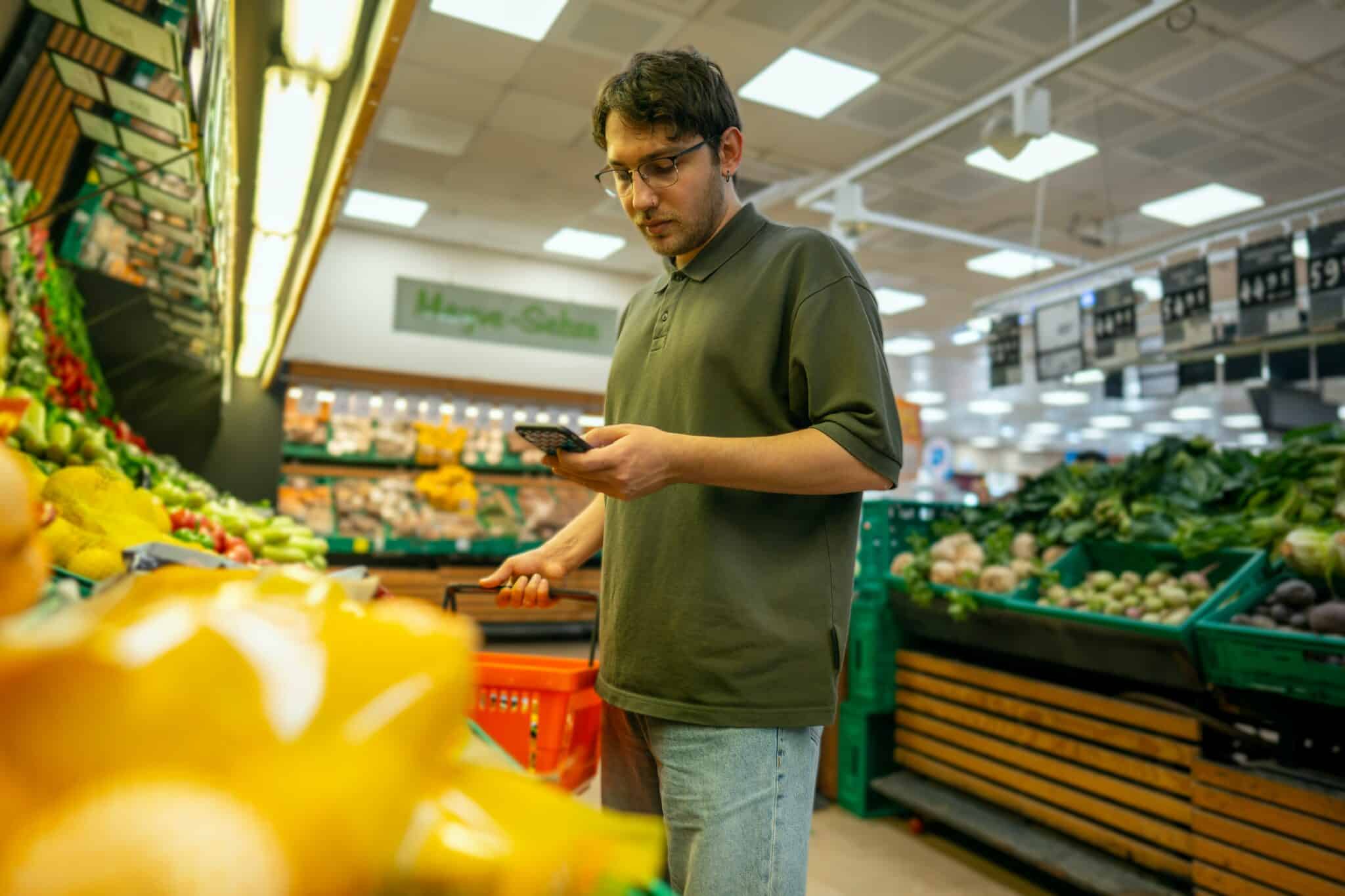Artificial intelligence has the power to assist grocery stores with everything from supply chain optimization to spoilage and food waste management. It’s also useful for enhancing real-time promotions, dynamic pricing, and overall customer experience. Of course, new AI technology also comes at a hefty price that some stores may find prohibitive.
Grocery stores have some of the thinnest profit margins of any retailer; historically, according to NYU Stern, grocers stand to net 1–3% annually. During the peak of the COVID-19 pandemic, profits for food stores doubled in some cases. But those extra percentage points have since dropped, even as food costs continue to rise. Given the narrow revenue potential, grocers may not yet be ready to adopt AI. With all that said, increased usage of this emerging technology is likely to come to a store near you.
According to Grocery Doppio, an independent source for grocers, AI utilization is projected to grow exponentially in the grocery space. The adoption of these new systems is expected to unlock more than $135 billion in value by 2030. The biggest growth potential is predicted in the supply chain and logistics fields, though merchandising and marketing aren’t far behind.
The same report makes it clear that AI adoption has been slow in the industry, with cost being the top inhibitor. Other challenges include inadequate technical infrastructure, a lack of proof of return on investment (ROI), and limited access to AI experts for implementation.
Key Takeaways:
- Choose the right AI tool for your business by finding out which training data a company uses, and ask if the company has the right expertise
- Grocers that adopt AI early may gain an edge over competitors through data collection and data-driven insights for better ad targeting, promotions, and personalization
- AI technology can help grocers with supply chain optimization, customer experience, and dynamic pricing
- Food retailers need to be cautious of providing benefits to customers only online to prevent unintentional discrimination (digital redlining)
- AI for small businesses can be cost-prohibitive, but you can start small and build on your strategy over time
What happens if grocers don’t adopt AI tech now?
Author Neil Sahota of Own the A.I. Revolution confirmed the challenges of AI implementation that face food retailers today.
“There’s a cost to the infrastructure,” he says. “Even if it’s really a one-time cost for grocery stores, you know the margins aren’t that great to begin with, so it’s a huge capital investment on their part.”
In addition to cost, Sahota said, it also comes down to what consumers want—or don’t want, in this case. He says some people aren’t ready for AI, such as older generations that prefer to speak personally to a checker or a produce manager. Human interaction remains a significant draw for many shoppers. Not all AI advancements mean removing the human element; rather, it can help increase personalization for customers.
Early adoption of AI technology could give grocers a competitive edge with shoppers, but food retailers who sleep on AI risk losing both current and future customers. Shekar Raman, CEO of Birdzi, an AI solutions company specifically for food retailers, shared his insights from the 2024 conference Groceryshop. The article outlines why it’s critical for grocers to lean into data-driven approaches with the help of AI. At the heart of these efforts is personalization for grocers.
“Largely, the market has made it obvious you have to be a data-driven company if you want to succeed,” Raman said in an interview. “There’s a size of retailer that’s hesitant. They’ve been doing more legacy stuff for a longer time, and maybe that works because you only have five stores and you’re in a rural area … their apprehension to invest dollars in AI may be higher.”
Maintaining a traditional approach in grocery advertising and promotion could be detrimental. “Only a small percentage of the total universe of shoppers in the retailer’s market area are drawn to shop because potential customers do not receive the degree of personalization that aligns with their evolving preferences and expectations,” Raman wrote in a 2024 Grocery Doppio article.
Costs are expected to decrease over time
Not all retailers are facing doom and gloom, unless they fail to hear the alarms going off, Raman said. He likened it to the personal computer, which was expensive and out of reach for many when it was introduced, but quickly became ubiquitous.
“I think there’s going to be a black swan effect that’s going to happen,” he said. “…AI and other technologies’ affordability will no longer be a factor.”
Overall, smaller retailers may benefit from waiting until AI becomes more attainable, but Raman believes it comes down to location. Smaller urban grocery stores, rather than rural ones, tend to be more enthusiastic about new technologies, as they aim to compete with larger retailers that have larger budgets for AI.
Forecasting the future
Consumer data has been a major player in the grocery industry since the 1990s when loyalty programs were launched, and has advanced significantly since then. Computer-assisted ordering made it easier than ever for retailers to plan for products when they needed them. Combine the consumer data with more advanced ordering technology, and you get better demand forecasting so grocers know to stock hot dogs and buns the week before Memorial Day or Fourth of July.
Now, demand forecasting uses machine learning (ML) and AI to incorporate additional variables. Sahota says that AI is also used to help predict various aspects of the supply chain.
“We’re actually working in the food supply chain with not just grocery stores, but actually farmers, as well. We integrate climate data such as topsoil conditions, access to water, and thousands of variations of seeds to figure out…the optimal use of the land and how you divide up cash crops versus nutrition crops.”
Additionally, Sahota suggested that AI can help food retailers with automation for operational efficiences, using AI and internet of things (IoT) sensors to help track produce and optimize routes so food doesn’t sit on trucks for long periods of time.
Image recognition is another way grocery stores are using AI to scan fruits and vegetables to ensure each piece is ripe, not rotten or otherwise unsuitable for customers, according to Sahota.
The rise and roadblocks in AI pricing
Dynamic pricing is a mixed bag for grocery stores and consumers alike. Adjusting prices in real time to account for supply, demand, and competitor pricing is much easier with the help of AI. On one hand, it could provide customers the best price for, say, a tomato, or you may be paying a premium, depending on several factors.
The benefits are obvious: reduced food waste and the best prices to keep customers coming back to the store. The drawbacks include concerns about price gouging, data privacy issues, and potential discrimination.
In a 2023 survey by Dalhousie University, Canadian respondents were largely uncertain about AI in the food store and service sector, but 26.5% worried about negative impacts on jobs and 21.8% were concerned about their privacy. Only 16.3% of those surveyed thought AI in grocery stores was a good idea.

Is AI discriminatory?
Digital redlining, a form of discrimination that occurs when access to digital coupons, promotions, and online shopping is limited, may be something grocers need to consider as they roll out AI-powered tools that don’t automatically address ethical concerns.
For example, one result of digital discounts that one can only get from apps on smartphones could be increased “food deserts,” a term describing areas that lack access to affordable and nutritious foods (now commonly referred to as “low-income and low-access” areas). Targeted marketing campaigns also segregate customers based on various demographics, which could lead to discrimination–unintentional or otherwise.
“A lot of this is based on past purchasing behavior,” Sahota said. “Some places like Walmart employ what’s called a smart shelf. So … if you’re looking at a product for a minute or two, but you don’t buy it, they may try to tag you with a special coupon … but it could skew the results that their algorithms are prioritizing things that we call false patterns.”
The potential to make life easier
Most grocery stores offer an app that customers can download and use to access loyalty programs, weekly sales, and create shopping lists. These conveniences are enticing to consumers, and they provide retailers with the data they need to push specific items they already know you will purchase. The new frontier may be grocers using AI to create personalized discounts for individuals and not the public at large. For example, you may get a coupon for $1 off a soda brand because you buy soda often, but your neighbor gets a coupon for $1 off juice. Sahota said he thinks we’re already about 70% of the way there.
“They’re using AI to look for patterns to either incentivize you to try a new product with a coupon or [to] remind you, hey, you might be running out of milk,” he said.
Of course, things don’t always work as intended. Sahota likened a supply-and-demand pitfall that occurs often with event tickets. The secondary ticket market may show lots of tickets for sale, so the prices are low–but 24 hours before the event, for any number of reasons, the tickets are suddenly gone. The result is that AI sees supply is low, assumes demand is high, and raises ticket prices. And then fewer people buy tickets.
Reclaiming your data is impossible
Another issue with AI-powered suggestions in grocery store apps is when a customer buys something that’s out of the ordinary for them. Sahota told a story about an executive who, ironically, runs a retail industry sector for a major consulting firm. She watched her 5-year-old nephew for a bit and used an app to look for child-appropriate snacks.
“Two years later, she still gets bombarded with children’s foods even though she doesn’t have kids,” Sahota said.
Currently, there is no way to undo that part of the algorithm.
Designing the perfect aisle
Consider the layout of a typical grocery store. Produce is usually on one side, and frozen items on the other. Generally, dairy and meat products are located toward the back, while packaged goods line the aisles in the center. The design has been optimized to maximize a customer’s time in the store. Now add smart shelves, AI assistance, and an app that potentially tracks your movement through the store. Slowly, grocery stores will adjust their product placement based on consumer data, sales, and bundling similar items. And it doesn’t stop there.
“The more we get into personalized [data] … the more we could have our app tracking our route for influence,” Sahota said.
Grocery store apps have store layouts, so you know exactly which aisle to visit next and can follow your dot in the app as you walk through the store. Target and Walmart apps include this feature already. Some stores offer kiosks or tablets where you can ask about an item, and it will tell you the exact location in the store.
The surprising ways grocery stores use AI
What might surprise many people, according to Sahota, is how much grocery stores are mining social media for customer data. They want to understand their customer base on a more personal level to get ahead of the competition.
“They’re finding social media is a wealth of information for … marketing to a 19-year-old versus a 49-year-old … especially as it seems like the younger generations are more like foodies,” Sahota said.
A big push for many food retailers today is private labeling, and food retailers are figuring out what customers want by combining social media data and AI. Consumers are experimenting more with private label purchases, largely due to higher costs. Amcor is a global packaging company that reported on European interest in private labels, which closely mirrors the US view. In the 2023 Amcor study, pricing was the top reason for 85% of those who chose a private label. Promotions encouraged 48% to purchase a private label product.
“They were using AI to figure out, hey, for a lot of people it’s meatless Monday, right? So, we should stock up more on these types of (foods),” Sahota said.
He thinks AI also holds a lot of power for new food development. Working with Bon Appetit, he created an AI chef that invented new recipes that people wouldn’t normally try, such as a chocolate Austrian burrito or a Vietnamese apple kebab. The new recipes turned out to be a hit.
“(AI) sees food as chemistry,” he said. “So it knows the chemical combination that produces flavors, smells, colors, and nutrition.”
Two questions to ask before implementing AI
As exciting as the AI revolution is for food retailers, it comes with caveats and challenges for many, especially small businesses that may not have the budget for the infrastructure. Sahota has specific advice for those who want to dip their toes into the technology.
“There are two questions you always need to ask,” he said. “First, whoever you’re talking to about their tool, ask them if they truly have the expertise.” It’s crucial, for example, to have someone with experience in the grocery industry to consult on the AI tool. Otherwise, you may just be buying an AI tool that’s too generic.
“Second, I always tell them to ask what training data they used,” Sahota said. “You don’t have to ask for the secrets and the algorithms, but how they establish their…ground truth; the rules on decision making and what they use as a basis for training.”
Sahota reminds small businesses that AI is not software, so you shouldn’t treat it as such.
“The first thing you have to do is understand that AI is like a high-energy intern,” he said. “It’s ready to do whatever you ask it to do, no matter how tedious or boring. But you have to teach it how to do it first, right?”
Having a strong training strategy and reliable data, Sahota said, is integral to implementing AI for any grocery store, big or small.


